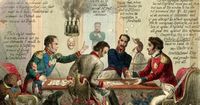On the third morning of the occupation of Moscow in 1812, Napoleon Bonaparte awoke in the Kremlin to alarming developments. The city was ablaze, as fires set deliberately by retreating Russian forces had escalated overnight, threatening to engulf the palace itself. An incident escalated when a Russian policeman was discovered attempting to ignite more fires within the Kremlin’s arsenal. A brief interrogation by Napoleon ensued, ending tragically for the officer as he was bayoneted to death. Philippe-Paul de Ségur, a French general who chronicled the 1812 campaign, vividly recounted Napoleon’s disbelief as he paced the Kremlin's halls, exclaiming repeatedly, “It is their own work! What men! – These are indeed Scythians!”
The narrative of transformation took a decisive turn eighteen months later, in March 1814, when Tsar Alexander I of Russia marched into Paris at the helm of an enormous coalition army of half a million troops comprising forces from Russia, Britain, Sweden, the Habsburg Empire, and various German principalities. Alexander’s intentions were portrayed as friendly; he assured the Senate that he was a “friend of the French people.” Contrary to the suspicions of previous Bourbons and their supporters, he pushed for a constitutional monarchy in France, trying to persuade Louis XVIII to retain the iconic tricolour flag, which signified freedom and revolution.
This wave of goodwill created wild rumors across Europe, fueled by his former tutor Frédéric-César de La Harpe's assertions of Alexander’s republican aspirations. De La Harpe suggested he was keen on liberalizing Europe, promoting free trade, and establishing a form of constitutional governance that could transcend the boundaries of Russia and reach the Atlantic world. As Alexander traveled to London later that summer, he was met with jubilant crowds, and prominent figures like William Wilberforce applauded his stance against slavery, dubbing him “the benefactor, not only of Europe, but of the human race.”
Undeterred by Napoleon’s return to power briefly in 1815, Alexander solidified his reputation as Europe’s savior on Christmas Day with the publication of a pivotal treaty between himself and the rulers of Prussia and the Habsburg Empire. This treaty birthed the Holy Alliance, aiming to eradicate wars among the signatories while promoting principles of fraternity and justice, with special emphasis on the responsibilities of monarchs to govern benevolently and justly towards their people.
The drafting of the Holy Alliance treaty involved consultations with Alexander’s foreign minister Ioannis Kapodistrias and his secretary Alexander Sturdza, both who would later become prominent figures in the fight for Greek independence. Despite its intended harmonious message, the treaty's tone became conservative due to revisions made by Metternich, the foreign minister of the Habsburg Empire. It laid the groundwork for a comfortable yet oppressive alliance, which would soon come under deep scrutiny from revolutionary thinkers.
In the early years of the 1820s, the alliance began to face fierce resistance from various European factions. Conservatives in German territories embraced the alliance as a restoration of divine authority while British radicals like William Cobbett criticized it as the “infernal system” of despots. The stark opposing perspectives exemplified the growing rift between revolutionary ideals and conservative backlash as oppositional figures mobilized under the banner of liberal reform.
A notable critique was rendered by George Cruikshank in his 1821 illustration, depicting the Holy Alliance as a steampunk Terminator, forcefully oppressing dissent and screeching against individual freedoms. This was initially catalyzed by interventionist actions in response to revolutions in Naples and Spain, which seemed to embody the oppressive elements of the alliance.
The context leading to the present-day discourse around the Holy Alliance resonates beyond mere history, resonating through centuries of political theory and ideals. Alexander I’s adept self-presentation as a virtuous monarch, striving toward enlightened governance, created footholds for his reign. The notable exchange of letters and political ideas between European intellectuals and the Romanovs during this time indicated a yearning for reform, integrity, and an escape from the scars of despotism.
Immanuel Kant encapsulated this sentiment with his essay, “Towards Perpetual Peace,” predominantly advocating for a unifying republic responsible for mediating European tensions. Ironically, after Alexander’s ascension to the throne in 1801, the dynamics in Europe shifted unfavorably toward power conflicts in which Russia, previously suspected of being despotic, began to find newfound admiration. This elevated perception suggested that under Alexander’s leadership, Russia could emerge as a stabilizing force.
The United States showed interest during this period; in 1806, Thomas Jefferson communicated with Alexander, proposing cooperative endeavors that could potentially reverse British trade restrictions against the US. Jefferson viewed a partnership with France and Russia as a means to deconstruct Britain’s economic supremacy, hinting at the ideologies of diplomacy that would later define European developments.
As the former agreements of aid and friendship between European kingdoms began to falter, underlying complexities were illuminated, revealing how the nostalgic alliances led to unforeseen outcomes of extensive violation of women's rights, social reforms, and political power struggles. For females within these spheres, the implementations of liberal ideas remained often elusive. Just as Juliane von Krüdener emerged as a key figure rallying for anti-Napoleonic sentiment, negative connotations emerged around her interpretations of majestic authority, with detractors deeming her sentiments nonsensical mystical extravagance.
The portrayal of individuals like Krüdener and the reactionary forces against her liberal ambitions illustrate the tension between progressive ideals and the detrimental effects of despotism. For every noble intention, history delineates an endurance of conflict and struggle that next generations of revolutionaries would inherit as a call to action.
In the long run, the convoluted legacy of the Holy Alliance reverberated throughout the 19th century, permeating the revolutionary sentiments of 1848 and beyond. Reflecting on the array of political views spawned by that turbulent time, both Marx and Engels would come to design their own representation of a “holy alliance” to reflect this dichotomy of reactionary and revolutionary forces at war across Europe.
Nakhimovsky critically engages with this legacy throughout his exploration of the Holy Alliance and its implications, thereby opening discussions on how similar themes resurface in modern political discourse across global alliances. The eternal drive for cooperative governance built on foundational principles takes a backseat to the brutal realities of historical power struggles that highlight fraught relationships between nations.
Ultimately, despite the seemingly united front presented by the Holy Alliance, the realities of the social and political relationships defined their depth; reverberating loudly through the passages of history, its legacy, though complex, serves as a crucial chapter that resonates with the aspirations of striving societies.




